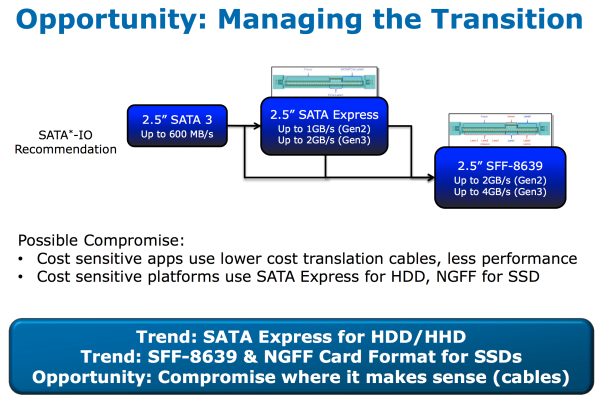Breaking the SATA Barrier: SATA Express and SFF-8639 Connectors
by Anand Lal Shimpi on September 13, 2012 2:41 PM EST- Posted in
- IT Computing
- SSDs
- Intel
- SATA Express
- Trade Shows
- IDF 2012
Pretty much all high-end client SSDs have no issues saturating the current 6Gbps SATA interface. We've talked about a move to PCIe based SSDs but these are the connectors that will do it.
On the right you have SATA Express, which will deliver up to 1GB/s on PCIe 2.0 and up to 2GB/s over PCIe 3.0. On the left there's the eventual landing place: the SFF-8639 connector, good for PCIe x4 with speeds of up to 4GB/s (PCIe 3.0).
Most client machines will likely use the new NGFF card form factor, but for huge capacities and performance (e.g. servers in the enterprise) we'll see a move from SATA to SATA Express to the SFF-8639 connector over the next few years.











20 Comments
View All Comments
Movieman420 - Thursday, September 13, 2012 - link
All I can say is...Bring it!! Even at only 1GB/s...the sata express has just about the right bandwidth to handle and internally raided 2.5" running a pair of 6gb/s controllers. I have one of the first internally raided drive...my old Ocz Apex. I think the Collosus was the most recent raided ssd afaik. Would love to see the Marvell or SF controllers paired up...the 1GB limit will bottleneck but only just a little, not enuff to 'feel' though.Mathieu Bourgie - Thursday, September 13, 2012 - link
Faster SATA standards couldn't come fast enough indeed with SATA III limiting the performance of modern SSDs.However, I'm curious to know what will be the physical size of those new SATA connectors? Are we talking about something identical or similar in size to current SATA connectors, or something completely different?
I ask because more and more people are moving toward smaller form factors for PCs, with Micro-ATX and Mini-ITX builds being more and more common.
Unfortunately, the vast majority of the current crop of LGA1155 motherboards only have up to 4 SATA ports, with two exceptions (ASUS P8H77-I and JetWay JNF9A-Q67) neither of which are based on the Z77 chipset, meaning that you have no option if say you want an overclocked high-end SFF PC with a dedicated video card and 6 SATA drives.
For example, the BitFenix Prodigy case support five drives + one optical and can support even more if you use a 3.5" drive bay that support two 2.5" drives or if you use the ICY DOCK MB994IPO-3SB 5.25" bay which supports a slim optical drive and two 2.5" SATA drives.
All that to say that I hope that it's not significantly larger, otherwise storage options will be limited on Mini-ITX motherboards and even more with even smaller form factors that Intel is pushing for.
A5 - Thursday, September 13, 2012 - link
You can read the spec here: ftp://ftp.seagate.com/sff/SFF-8639.PDFFrom a quick reading, SFF-8639 looks to be about twice the width of the current SATA data connector. The full connector looks to be about 40mm wide.
repoman27 - Thursday, September 13, 2012 - link
It's an extension of the SFF-8482 SAS connector, i.e. the female socket will accept any standard 2.5"/3.5" SATA or SAS drive.It's the same size as the SATA power and data connectors if you joined them together.
DuckieHo - Thursday, September 13, 2012 - link
Is SATA Express a new protocol or connection?I assume the disk controller will not have to support both PCIe and SATA since this will drive up costs. So that means there will be additional wiring required for support like how all mSATA slots are miniPCIe but not all miniPCIe are mSATA?
extide - Friday, September 14, 2012 - link
not all mSata slots are mini pcie, and not all miniPCIe are mSATA. Infact most of them are only the one type. On some boards they have an option in the bios to switch them but in tact case the mobo is changing out what the pins connect to entirely.repoman27 - Thursday, September 13, 2012 - link
So I read the post about NGFF and was like, "Heck, yeah. Finally."Then I read this one and was like, "WTF?"
After reading this: http://www.sata-io.org/documents/SATA_Express_Arti...
I think I get it now.
These connectors are physically compatible with current SAS/SATA power+data cables, but allow for devices that use 1 or 2 PCIe lanes instead of conventional SATA signaling. Or in the case of SF-8639, up to 4 PCIe lanes or an x2 SAS/SATA connection.
I guess there's a point to this, although it seems like clinging to old form factors for no good reason. Wouldn't it make more sense for future motherboards to have a few SATA 6Gb/s connectors coming off of the I/O hub for legacy storage and a few NGFF slots off of the CPU for solid state storage?
B3an - Thursday, September 13, 2012 - link
So what about desktops? SATA Express and SFF are for servers and enterprise. And NGFF is for ultrabooks.What do us desktop users get??
repoman27 - Thursday, September 13, 2012 - link
Despite what the "Trend:" block above states, it seems more likely that:SFF-8639 is for enterprise, replacing conventional SAS for SSDs using 2.5/3.5" form-factors.
SATA Express is for the desktop, replacing SATA 6Gb/s for SSDs using 2.5/3.5" form-factors. The motherboard connector would appear to be backwards compatible with previous generations of SATA. You just need the right cable in order to utilize the fastest interface a given drive supports.
Instead of SATA 12Gb/s, we're getting SATA Express as the next generation SATA interface.
rstuart - Thursday, September 13, 2012 - link
Just what we need. Another bloody cable for carrying PCI/E. It's not like there is any lack of ePCIe cables around now. Why not use something that already exists - like Thunderbolt.